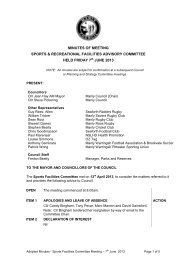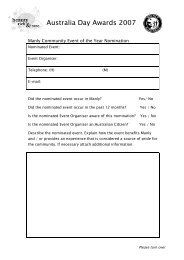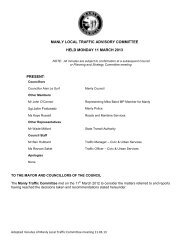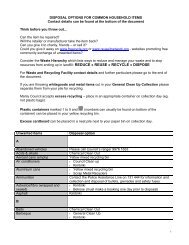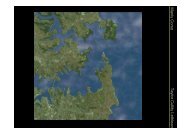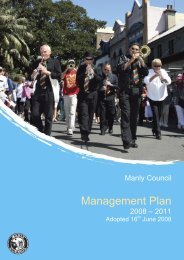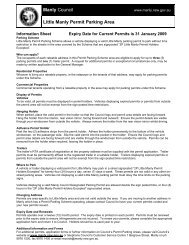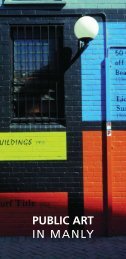Manly Lagoon Dredging Project - Manly Council - NSW Government
Manly Lagoon Dredging Project - Manly Council - NSW Government
Manly Lagoon Dredging Project - Manly Council - NSW Government
- No tags were found...
Create successful ePaper yourself
Turn your PDF publications into a flip-book with our unique Google optimized e-Paper software.
<strong>Manly</strong> <strong>Lagoon</strong> <strong>Dredging</strong> <strong>Project</strong> – Review of Environmental FactorsPrepared for <strong>Manly</strong> and Warringah <strong>Council</strong>sdredging sample. The upper end (100ppm) of the flocculant range would be safe for aquaticbiota, because in a “worst case scenario” (assuming that the returned water would have aflocculant concentration of 100ppm), the concentration of flocculant in the receiving waterwould be at least an order of magnitude below critical doses to biota (Appendices C and I).Runoff water must be returned to the lagoon through a pipe (to minimise erosion associatedwith overland flow) and within the area of the silt curtains, and in a controlled manner tominimise the risk of increasing turbidity and/or erosion at the point of discharge.5.3.1 Measurement of TurbidityThe control of turbidity (or suspended solids) levels in the <strong>Lagoon</strong> is recognised as a keyenvironmental protection measure, and a rapid means of determining this is required toprovide management information in the field.It should be noted that turbidity and suspended solids are not the same measure. Turbidity isan expression of the optical property that causes light to be scattered and absorbed ratherthan transmitted with no change in direction or flux level through the sample. Correlation ofturbidity with the weight or particle number concentration of suspended matter is difficultbecause the size, shape and refractive index of the particles affect the light-scatteringproperties of the suspension (Eaton et al., 2005). For instance, using existing data, therelationship between field measured turbidity and NTU and laboratory derived values forTSS is not sufficiently strong to accurately predict TSS in mg/L from NTU measured using afield probe (R 2 = 0.2, p = 0.01, df=28).We consider however that a rapid indicator in the field is of high value as it providesinformation to the site management to enable decisions to be made supportingenvironmental protection, and given the presence of additional mitigation measures (e.g. siltcurtains) and the relatively small scale and short duration of the project the adoption of thesimple field test for turbidity using a field probe is appropriate without attempting to correlatethis back to suspended solids for every field measurement recorded.To enable a field probe measurement of turbidity (measured by a Yeokal 600 multiprobe orsimilar), to be used to determine whether or not water can be released into the lagoon, it isproposed to improve understanding of the relationship between Suspended Solids andTurbidity in the <strong>Lagoon</strong> by undertaking a regression analysis. This will be undertakenutilising 15 samples of water from the <strong>Lagoon</strong> in the three weeks prior to dredging, includingsamples of high and low turbidity, with samples being artificially agitated as required. Theanalysis is proposed at this time to provide data which is temporally and geographicallyrelevant to the dredging. The regression analysis will provide a value (in turbidity units)which will can be considered equivalent to 50mg/L, and this value will become the thresholdvalue above which water cannot be returned to the <strong>Lagoon</strong>.2 July 2010 Cardno (<strong>NSW</strong>/ACT) Pty Ltd 69H:\Doc\2010\Reports.2010\Rep2580v4.doc



